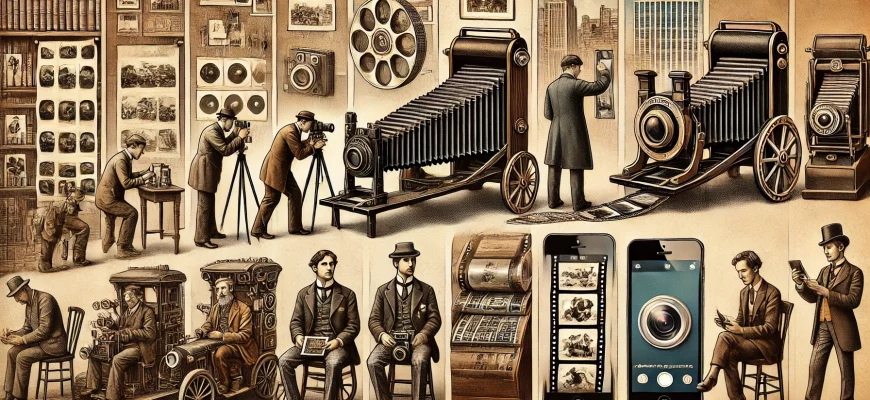The Inception of Photography: From Obscure Processes to Public Fascination Photography’s tale commenced in the 1800s’ dawn. Joseph Nicéphore Niépce, in 1826, produced the initial successful photograph, which demanded an exposure duration of eight hours using a technique known as heliography, which involved a pewter plate with bitumen. Louis Daguerre, however, was pivotal in propelling photography towards practicality and wider reach. His 1839 unveiling of the daguerreotype cut down exposure times significantly and yielded precise, clear imagery on silver-plated copper. This procedure necessitated a meticulous approach, confining it to darkrooms, and underlined the art’s intricacy and selectiveness.
The Emergence of Film: A New Chapter in Capturing Visuals The closing years of the 19th century saw George Eastman introduce the iconic Kodak camera in 1888, transforming photography’s paradigm. His key innovation was in streamlining the image-capture process, enabling users to utilize roll film instead of cumbersome metal plates. The mantra “You press the button, we do the rest” represented the newfound simplicity. Roll film not only made photography widely accessible but also laid the groundwork for the motion picture industry.
The Infusion of Color: Enriching the Photographic Palette Despite early experiments with color photography, it wasn’t until the 1930s that it found commercial footing. Kodachrome film, released by Eastman Kodak in 1935, granted photographers the ability to produce vivid, colorful pictures. This advance brought novel shooting and developing methods, broadening the horizons for photographic creativity.
The Digital Epoch: Crafting Imagery with Electronic Precision The advent of digital photography in the latter part of the 20th century marked a pivotal transition. Steven Sasson, an Eastman Kodak engineer, crafted the inaugural digital camera in 1975. Although rudimentary, with a hefty weight and low-resolution output, this technology rapidly advanced. By the 1990s, digital cameras became accessible and offered advantages such as instant image review and more efficient storage.
The Ascension of Smartphone Cameras: Seamless Imaging on the Go The turn of the millennium heralded the smartphone revolution, reshaping photography’s framework. Japan saw the launch of the first camera phone, the Sharp J-SH04, in 2000. Despite its modest 0.11-megapixel camera, it marked a paradigm shift towards integrated, readily available imaging tools.
Contemporary Smartphone Cameras: Technological Mastery and Influence Present-day smartphones challenge conventional digital cameras with their sophisticated multi-lens arrays, advanced sensors, and intelligent software. Devices like the iPhone and Samsung Galaxy deliver high-definition photos, intricate image processing, and emulate professional techniques. Artificial intelligence and machine learning further refine image quality and the user experience with features such as scene detection and auto-adjustments.
The Societal Transformation: Visual Communication as a Global Phenomenon The omnipresence of smartphone cameras has recast photography from a niche skill to a pervasive communicative medium. Social platforms such as Instagram and TikTok have positioned visual narratives at the heart of daily exchanges. This universal access has enabled countless individuals to capture and disseminate their experiences, cultivating a worldwide culture of immediate visual sharing.
Prospects for Photography: Merging Realities and Expanding Horizons Technology’s relentless progression foreshadows further breakthroughs in photography. Augmented and virtual realities are merging tangible and digital realms, offering novel modes of capturing and experiencing visuals. Computational photography is redefining potentialities, enabling awe-inspiring effects and artistic innovation previously inconceivable.
Conclusion Photography’s metamorphosis spans from labor-intensive darkroom procedures to the ubiquity of smartphone cameras, mirroring vast technological and cultural shifts. What began as an arcane art has turned into an everyday fixture. As we look forward, photography’s trajectory is set to continue influencing and adapting to our modes of expression and connection. The photographic narrative, rich with history and potential, invites both avid amateurs and seasoned professionals to anticipate its unfolding chapters.








